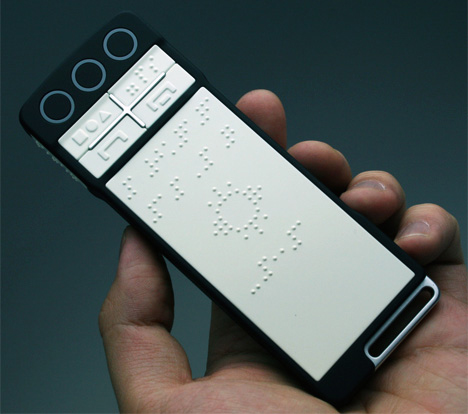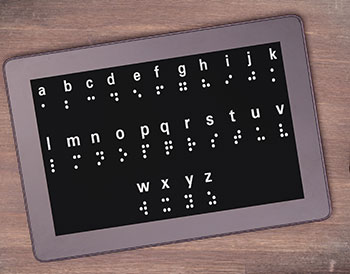Empowering Independence With Assistive Technology for the Blind
The combination of assistive technology right into the lives of people with visual impairments stands for a substantial innovation in advertising self-reliance and self-sufficiency. From cutting-edge screen readers to innovative clever canes, these tools not just improve day-to-day navigating and interaction but additionally equip customers to involve meaningfully in various elements of life. As we check out the myriad advantages and real-world applications of these modern technologies, it comes to be vital to examine the hidden elements that add to their effectiveness and the potential for future developments in this vital field.
Overview of Assistive Technology

The growth of assistive innovation is based in concepts of inclusivity and empowerment. Innovations in software, equipment, and sensory enhancements supply customers with choices customized to their particular requirements. From display visitors that convert text to speech, to responsive tools that convey info with touch, these tools change the means people engage with their environments.
Along with sensible applications, assistive innovation cultivates greater social inclusion and involvement in numerous fields, including education and learning and work (Mobility aids for visually impaired users). As r & d proceed to advance, the potential for assistive innovation to better boost the lives of aesthetically damaged people remains encouraging, paving the way for an extra equitable society where everybody can thrive
Sorts Of Assistive Devices
A selection of assistive gadgets have emerged to sustain people with visual problems, each created to fulfill particular needs and improve everyday performance. These devices range from low-tech solutions to high-tech innovations, supplying diverse choices for customers.
Low-tech tools consist of magnifiers and large-print products that assist in reading and writing. Braille devices, such as Braille slates and styluses, make it possible for responsive analysis and communication. Orientation and movement help, like white walking sticks, assist users browse their setting safely.
On the higher end of the spectrum, electronic magnification systems and display readers supply significant support. Electronic magnifiers allow users to enlarge message and images on screens, while screen viewers convert digital content right into synthesized speech, assisting in accessibility to info on smart devices and computer systems.
Smart device applications likewise play a critical role, providing features like text acknowledgment and navigating aid. Wearable modern technology, such as wise glasses furnished with increased reality, is emerging as an appealing device to boost situational awareness.
Benefits of Assistive Modern Technology
The integration of assistive innovation considerably boosts the quality of life for individuals with visual problems. These technologies equip users by promoting independence, allowing them to browse their atmospheres a lot more properly and do everyday jobs with greater convenience. Screen visitors and zoom software program enable people to accessibility digital information, fostering educational and expert possibilities that may have formerly been out of reach.
Additionally, assistive devices such as wise walking canes and GPS applications supply real-time navigating assistance, boosting wheelchair and safety. This increased autonomy not only enhances self-esteem however additionally motivates social interaction, permitting users to take part more fully in their communities.
Assistive modern technology likewise promotes interaction, helping users attach with others with voice recognition and text-to-speech applications. This capability is click for more info important for maintaining partnerships and accessing important info.
In addition, the personalization choices available with many assistive innovations make sure that individuals can customize devices to their specific needs, even more improving functionality and efficiency. On the whole, the advantages of assistive technology for people with aesthetic impairments are profound, promoting an extra comprehensive culture where everybody can seek their address goals and goals.
Situation Researches and Success Stories
Highlighting the transformative impact of assistive innovation, countless case researches highlight exactly how individuals with aesthetic problems have actually successfully incorporated these tools right into their every day lives. One engaging instance involves an university student who utilized screen analysis software to navigate scholastic materials and on the internet resources efficiently. This modern technology not only promoted her education and learning however additionally boosted her confidence in joining conversations and team tasks.
One more study includes a specialist who employs a smart device application designed for navigating and item acknowledgment. By utilizing this application, he has actually gained back freedom in both his personal and work environments, allowing him to commute separately and involve with coworkers a lot more successfully.
Furthermore, a senior citizen shared her experience with braille e-readers, which allowed her to access a substantial array of literature and remain gotten in touch with her community via book clubs.
These success stories highlight the essential role of assistive technology in promoting independence, enhancing lifestyle, and promoting social combination for people with visual disabilities (Braille displays and notetakers). By welcoming these cutting-edge tools, customers can get over difficulties and take chances that add to their personal and professional satisfaction

Future Fads in Assistive Technology
Advancement in assistive innovation is poised to redefine the landscape of assistance for people with visual problems. Arising fads stress the assimilation of man-made intelligence (AI) and artificial intelligence, which boost the capability of devices that assist with navigating and details accessibility. AI-driven applications are currently capable of translating aesthetic data in real-time, making it possible for individuals to engage with their environment much more independently.
Additionally, the advancement of wearable modern technology is advancing rapidly. Smart glasses equipped with enhanced reality (AR) can give audio descriptions of environments, visit this page changing how users engage with public areas. These devices not only promote autonomy yet also foster social inclusion.
Additionally, the Internet of Things (IoT) is making homes smarter, permitting for seamless connectivity between daily devices and assistive tools. This connectivity empowers customers by making it possible for voice-activated controls and computerized reactions customized to specific requirements.
Conclusion
Finally, assistive innovation plays an essential function in empowering individuals with visual impairments by enhancing their independence and involvement with their environments. The varied variety of devices and applications offered not only assists in navigation and interaction however also advertises social combination and possibilities for professional and individual growth. As developments proceed in this field, the potential for improving the high quality of life for those with visual problems will certainly broaden, promoting higher autonomy and empowerment.
